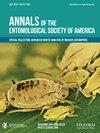Pollination by Non-Apis Bees and Potential Benefits in Self-Pollinating Crops
IF 3
3区 农林科学
Q1 ENTOMOLOGY
引用次数: 14
Abstract
Abstract The diversity and abundance of native bees (Hymenoptera: Anthophila) are important in providing pollination services to a diverse array of crops. An extensive literature base is available on the contributions of bees as crop pollinators. The focus of the majority of these studies are on honey bees (Apis spp.) pollinating crops that depend on cross-pollination to produce a yield. Self-pollinating crop species, including cotton, soybeans, coffee, and canola, can self-pollinate but there is increasing evidence that they can also benefit from cross-pollination by insects. These crops can see a considerable benefit when visited by bees in general, but contradictory evidence is not fully understood in some systems. For example, recent studies have shown that bee visitation to cotton blooms can increase yield up to 15%. Including nesting habitat for non-Apis bees within soybean dominated landscapes increases in-field yields. However, in these same systems, some studies show none or minimal yield increases. Additional literature (both recent and historical) of non-Apis bees in mass-flowering self-pollinating crops and their potential benefits to the crops also exists but is previously unsynthesized in cotton and soybeans in particular. In our review of literature on these select self-pollinating crops, there appears to be apparent gaps in the literature base on these and other understudied cropping systems. With the exception of graminaceous and cereal crops, all the crops discussed herein seem to have all have benefited from visitation by both Apis and non-Apis bees. Some provide known resource benefits to native bee pollinators like canola, but others like cotton and soybean are not well understood. Further, with an apparent yet small literature base in cotton and soybean there are many facets between the native bee pollinators and crop such as nutritional benefits of nectar and pollen to the bees themselves that still need to be addressed. To examine these underlying mechanisms, additional studies into the basic biology and natural history, including nesting habitats and preferences along with foraging preferences of abundant bee species will help understand how these bees seem to persist and possibly thrive in intensified agricultural systems.非蜜蜂授粉及其对自授粉作物的潜在益处
摘要本地蜜蜂(膜翅目:Anthophila)的多样性和丰度在为各种作物提供授粉服务方面很重要。关于蜜蜂作为作物传粉昆虫的贡献,有广泛的文献基础。这些研究的重点大多是蜜蜂(Apis spp.)为依赖异花授粉产生产量的作物授粉。棉花、大豆、咖啡和油菜等自花授粉作物可以自花授粉,但越来越多的证据表明,它们也可以从昆虫的异花授粉中受益。当蜜蜂造访这些作物时,通常会看到相当大的好处,但在一些系统中,矛盾的证据并没有得到充分理解。例如,最近的研究表明,蜜蜂造访棉花花朵可以使产量提高15%。将非Apis蜜蜂的筑巢栖息地纳入大豆主导的景观中,可以提高田间产量。然而,在这些相同的系统中,一些研究表明产量没有增加或增加很少。关于非Apis蜜蜂在大规模开花自花授粉作物中的作用及其对作物的潜在益处的其他文献(包括最近的和历史的)也存在,但以前在棉花和大豆中尤其没有。在我们对这些选择的自花授粉作物的文献综述中,基于这些和其他研究不足的种植系统的文献似乎存在明显的空白。除了禾本科和谷类作物外,本文讨论的所有作物似乎都受益于Apis和非Apis蜜蜂的造访。一些为当地蜜蜂授粉者(如油菜)提供了已知的资源优势,但其他如棉花和大豆的资源优势尚不清楚。此外,由于棉花和大豆的文献基础明显但很小,本地蜜蜂授粉者和作物之间有很多方面,例如花蜜和花粉对蜜蜂自身的营养益处,这些问题仍需解决。为了研究这些潜在机制,对基本生物学和自然史的进一步研究,包括筑巢栖息地和偏好,以及丰富蜜蜂物种的觅食偏好,将有助于了解这些蜜蜂似乎是如何在强化的农业系统中生存并可能茁壮成长的。
本文章由计算机程序翻译,如有差异,请以英文原文为准。
求助全文
约1分钟内获得全文
求助全文
来源期刊
CiteScore
4.90
自引率
0.00%
发文量
25
审稿时长
6-12 weeks
期刊介绍:
The Annals of the Entomological Society of America exists to stimulate interdisciplinary dialogue across the entomological disciplines and to advance cooperative interaction among diverse groups of entomologists. It seeks to attract and publish cutting-edge research, reviews, collections of articles on a common topic of broad interest, and discussion of topics with national or international importance. We especially welcome articles covering developing areas of research, controversial issues or debate, and topics of importance to society. Manuscripts that are primarily reports of new species, methodology, pest management, or the biology of single species generally will be referred to other journals of the ESA. The most important criteria for acceptance are quality of work and breadth of interest to the readership.

 求助内容:
求助内容: 应助结果提醒方式:
应助结果提醒方式:


